This pancit palabok recipe features rice noodles layered with a golden colored savory shrimp and pork sauce and topped with crispy chicharon morsels, fried garlic slices, steaming boiled eggs, fragrant scallions, and sprinkled with zesty lime juice.
You might be surprised to know that eating noodles is a part of many celebratory events in Filipino and Filipino American culture–just like other Asian cultures. Growing up, I ate pancit palabok for birthdays, holidays, and especially on New Years as a way to wish for a long life.
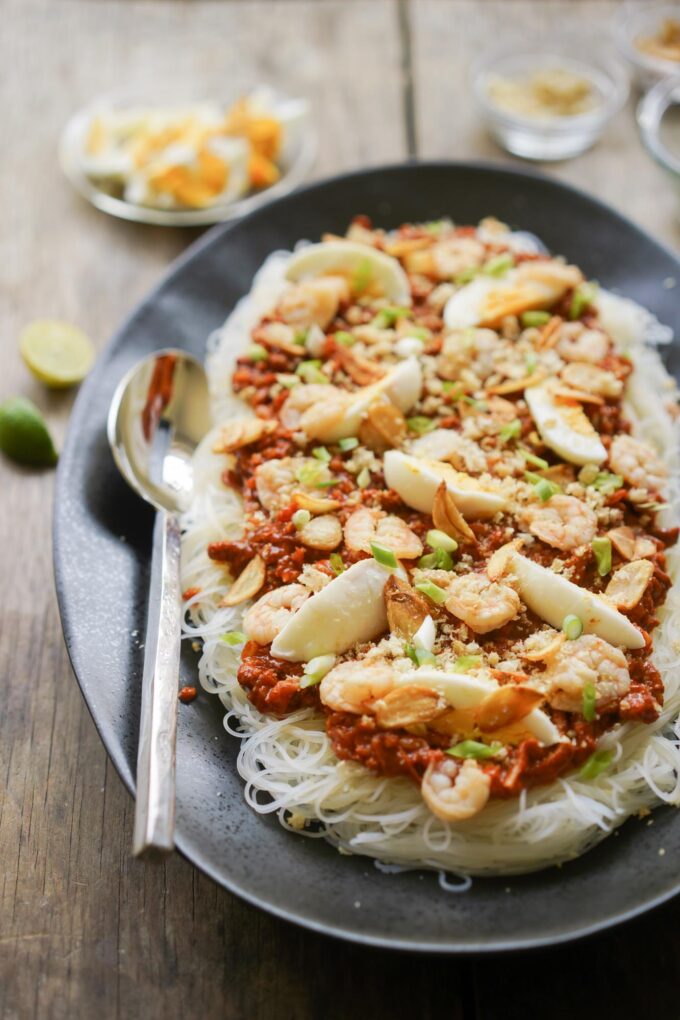
Pancit’s background
Noodles were introduced to the Philippines by Chinese migrants and the word “pancit,” which refers to the actual noodles and the dishes themselves, comes from the Hokkien word “pian e sit” (meaning dish that is conveniently cooked).
You might have even heard of pancit before, but did you know there are many variations? This means there are different types of pancit noodles from thick to thin, wheat to rice to mung bean noodles, in addition to the various dishes themselves.
For instance, pancit canton is probably more closely related to chow mein because it uses wheat noodles or sotanghon guisado is made with mung bean noodles and topped with carrots and meats like chicken.
The rice noodles
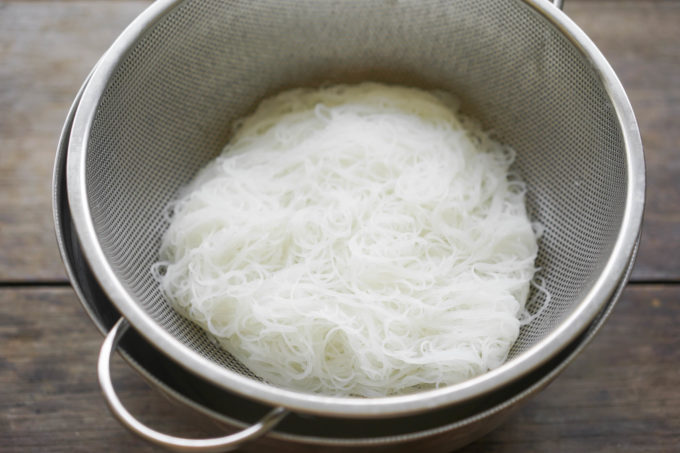
For this recipe, I’m making pancit palabok, which uses bihon type of noodles or thin rice noodles. Bihon noodles are what differentiates this dish from other pancit because the noodles are made of rice instead of mung bean.
You can find these types of noodles easily at a Filipino store or other Asian grocery stores, but make sure you choose the bag with rice noodles listed and not mung bean. Both of these noodles might be listed as glass noodles, so you have to read the ingredients list to verify. I prefer the Pamana brand rice noodles for pancit palabok.
Prepping the noodles is super easy, they just need to be soaked into cold water for about 15-20 minutes before boiling for about two minutes and blanched into cold ice water. I like to also place them in a strainer to remove excess water in the noodles while I finish making my palabok sauce and assemble.
The sauce
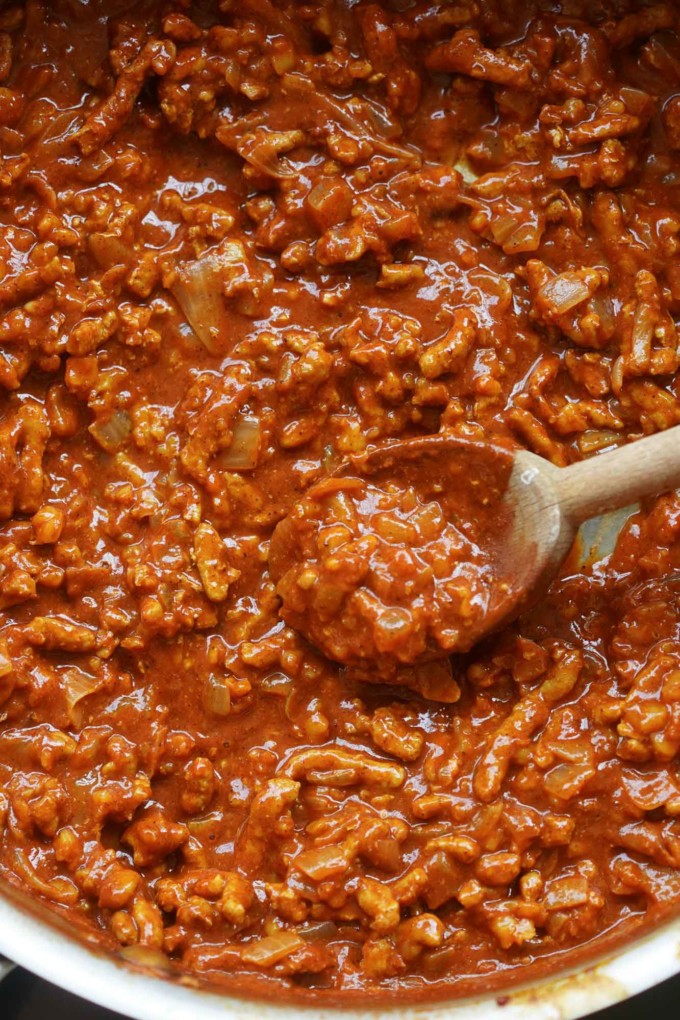
The bihon noodles for pancit palabok are topped with a savory meat sauce mixed with annatto powder to get its famous marigold color. While annatto powder is one way to get this amazing color, I also use seafood stock in my sauce to amp up flavor and color. Traditionally some recipes call for shrimp stock or shrimp bouillon and water if you have those on hand, which work fine too.
For this sauce, I use both shrimp and ground pork for an extra fatty flavor. Since I boil shrimp in seafood stock, I save some of the shrimp as a topping too.
Topping options
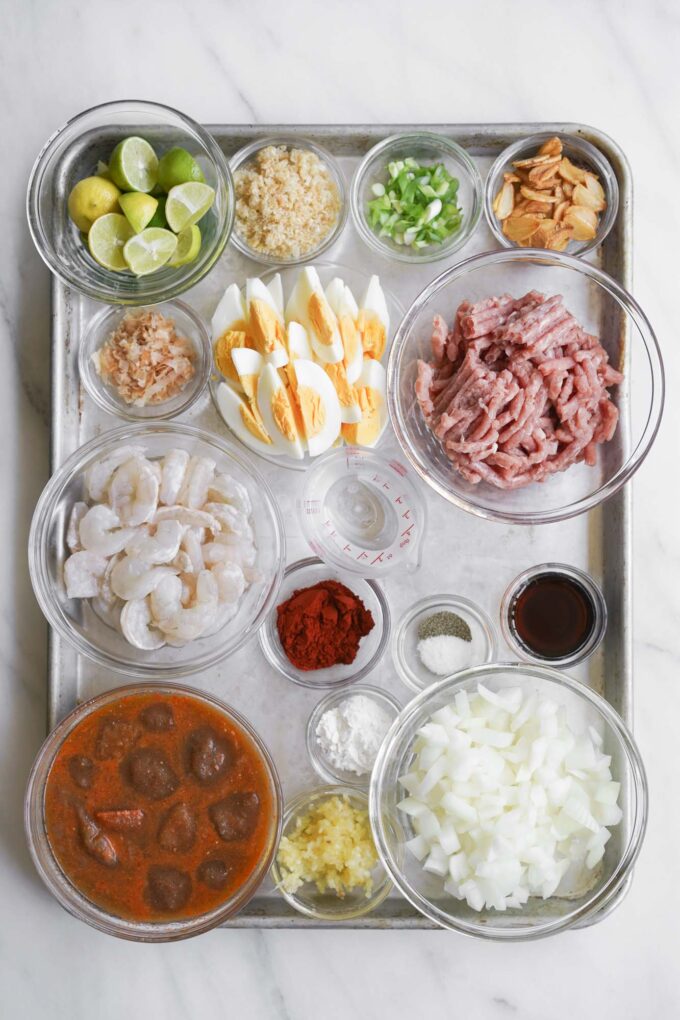
Pancit palabok often has a lot of different toppings, and for me, this is my favorite part! Typically during family parties, pancit palabok comes with toppings (unmixed so you get the full beauty of the dish), but it also comes with extra toppings to add on the side.
Some traditional toppings include: shrimp, sliced boiled eggs, scallions, crushed chicharon, fried garlic, smoked fish flakes, and more. Because this dish has so many toppings, I would really recommend starting the recipe by prepping the toppings, so that by the time the noodles and sauce are done, you can plop the toppings and eat away!
Cooking tips
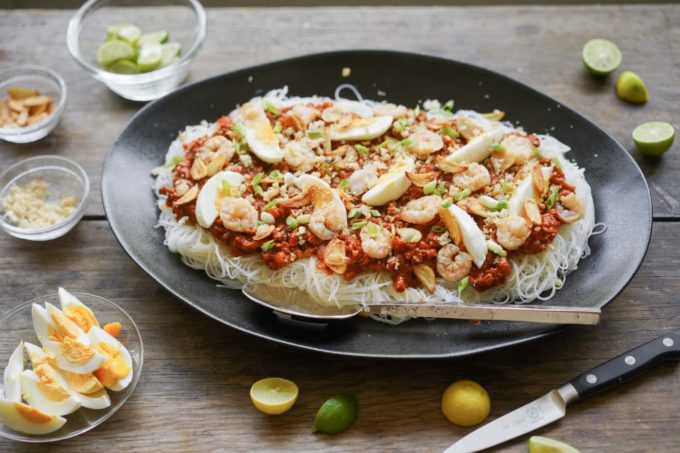
- Make sure you buy noodles labeled “bihon” or “rice noodles” for pancit palabok. Bihon is different from other glass noodles that are made of mung beans.
- Cook your shrimp in the seafood stock to amplify the flavor. You should also save about a quarter of the shrimp to use for the topping (I love this extra portion of shrimp).
- While my rice noodles are soaking, I will also cut them in half so it’s easier to handle them while I’m boiling the noodles AND while I’m eating them.
- Start this dish by prepping your toppings FIRST. I would say this is probably the most time consuming if you choose to make things from scratch like fried garlic slices. By prepping them first, your noodles and sauce won’t get cold.
What is the difference between pancit malabon and palabok?
Pancit malabon uses thicker rice noodles than pancit palabok with bihon noodles. Sometimes the toppings for pancit malabon is also simplified and the sauce is already mixed into the malabon noodles for presentation.
If you want other types of Filipino noodle dishes, you can also check out my Filipino spaghetti recipe too.
How long does pancit palabok last?
Pancit palabok typically lasts about five days in the fridge in an airtight container.
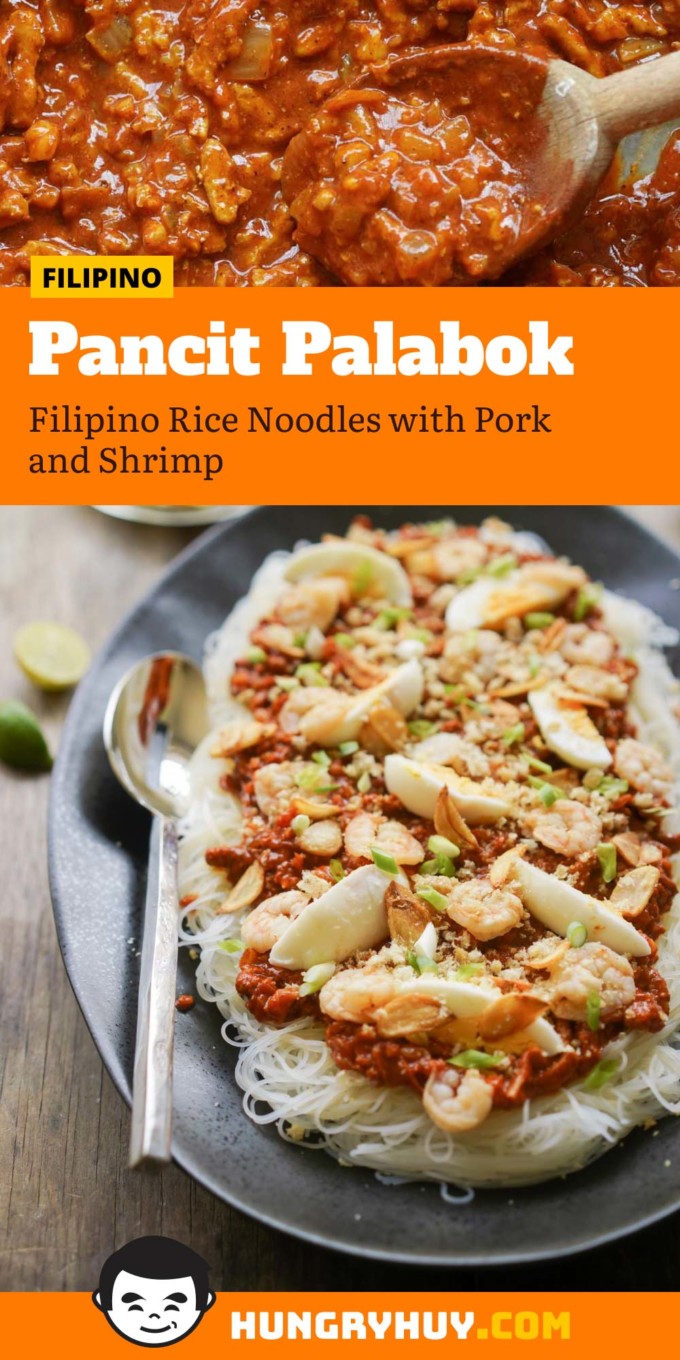
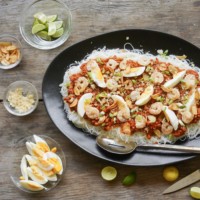
Pancit Palabok (Filipino Rice Noodles w/ Pork & Shrimp)
Ingredients
Toppings
- 1 bag premade chicharon
- 3 stalks scallions
- 4 limes or calamansi
- 5 cloves garlic sliced thinly
- 2 eggs
- 1 bag tinapa or smoke fish flakes
Shrimp
- ¼ lb (113.4 g) shrimp peeled and deveined
- 2 c seafood stock or 1 shrimp bouillon and 2 c water
Sauce
- ½ lb (226.8 g) ground pork
- 1 tbsp annatto powder
- 2 tbsp water
- 2 tbsp garlic (10 cloves) minced
- 2 c onions (1 medium onion) chopped
- 1 tbsp fish sauce
- ¼ tsp salt
- ¼ tsp pepper
- 1 tbsp cornstarch
- 2 tbsp filtered water
Noodles
- 7 oz bihon style rice noodles (½ pack) preferred brand Pamana
- 8 c filtered water
Instructions
Toppings
- Chicharon: Place chicharon in a food processor and grind until it becomes small, tiny pieces. Transfer into a bowl and set aside.
- Scallions: Clean scallions over running water and cut them on a bias in ¼ inch slices. Place them in a bowl of water, stir them around, and soak for about two minutes. Drain and transfer to a new container and set aside.
- Limes or calamansi: Clean limes in water to remove any dirt or residue and cut them into wedges.
- Fried garlic slices: Peel and cut garlic into very thin slices (about 2 mm). I like to use a mandolin on a very thin setting. Add one inch of vegetable oil to a small pot over medium-high heat and wait until it reaches 350 °F. Lower the garlic slices into the hot oil and fry for about two minutes or until they turn a slight golden brown. Remove the garlic and place onto a towel to remove excess oil. Set aside for later.
- Boiled eggs: Add eggs into a small sauce pan over medium-high heat and add water making sure to cover the eggs. Boil eggs in boiling water for 10 minutes. Remove the eggs and run them over cold water until they cool. Peel the eggs and slice into quarters. Set aside.
Shrimp
- Peel and devein the shrimp.
- In a small pot over medium heat, add the seafood stock. Bring to a simmer and then add the prepared shrimp.
- Cook shrimp for about two to four minutes or until the shrimp turns pink and feels firm to the touch.
- Remove shrimp from the stock and into a chopping board. IMPORTANT: save about 1 oz or ¼ of the shrimp to use for toppings. Use a sharp knife to chop the shrimp into minced pieces.
Sauce
- Submerge bihon (rice noodles) in cold water for 15 minutes.
- In a large saucepan over medium heat, add oil and onion. Saute onion for about two minutes or until they become slightly translucent. Add the garlic and cook for another 30 seconds or until fragrant.
- Add the ground pork and chopped shrimp into the saucepan. Stir the mixture to incorporate the onion and garlic.
- Add the seafood stock and stir again.
- In a separate bowl, whisk the annatto powder and water until it’s combined. Then, add this annatto liquid, fish sauce, salt, and pepper into the saucepan and stir. Cook for about two minutes.
- In a separate bowl, whisk the cornstarch and water. Then add this cornstarch water into the large saucepan. Continue to cook the sauce for about eight to 10 minutes or until it’s thickened.
- Remove the pan from the heat and set aside.
Noodles
- In a pot over medium high heat, add the water and wait for it to boil. Carefully lower the soaked rice noodles and stir. Boil for two minutes or until the noodles are soft (they should not be al dente).
- Transfer the noodles into an iced cold bath for about two minutes to stop the cooking process. Move the noodles into a strainer to remove excess water. You can also squeeze the noodles softly over the strainer to remove the water.
- To assemble pancit palabok: Spread out the rice noodles over a large serving platter and use a ladle to spread out the palabok sauce over the noodles. Then, layer the toppings however you desire on top.
- Serve immediately with extra limes/calamansi and chicharon powder on the side.

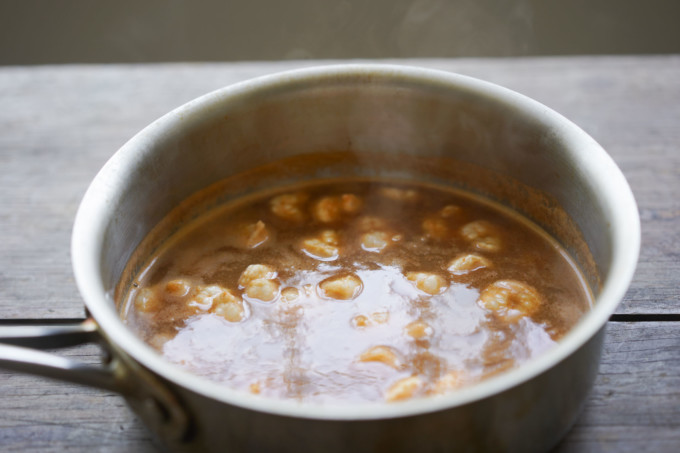
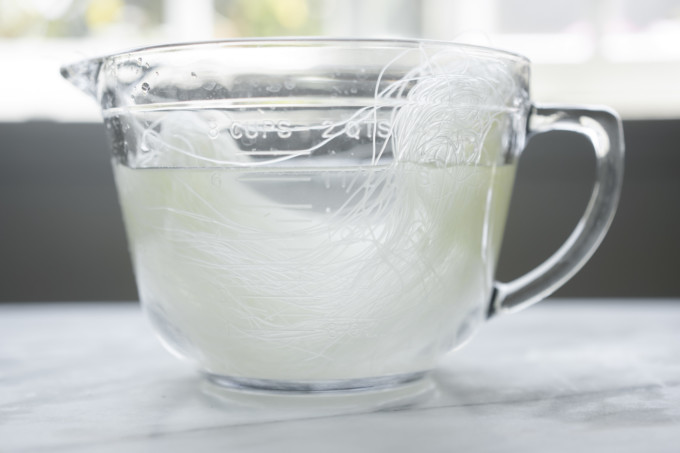
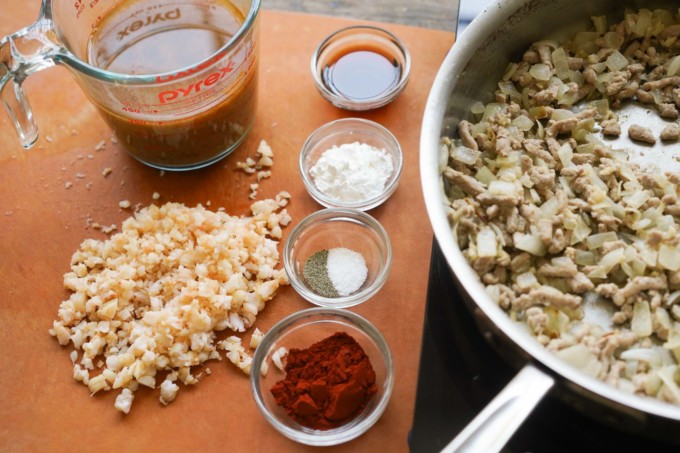









My favorite! Thank you for the recipe. This recipe looks good will make this when my husband requests a Palabok.